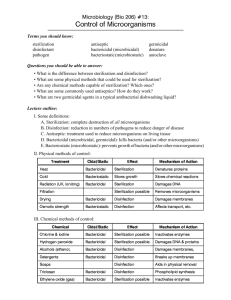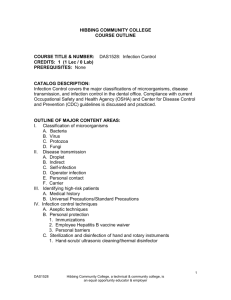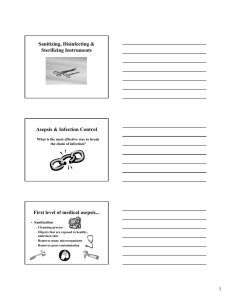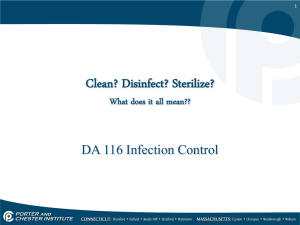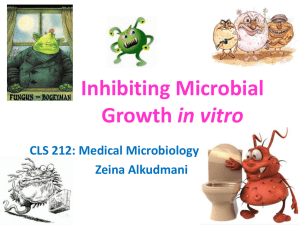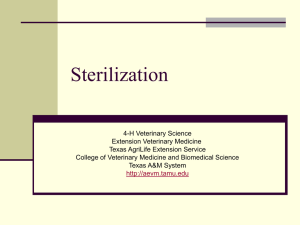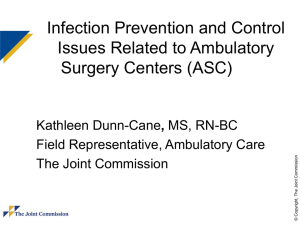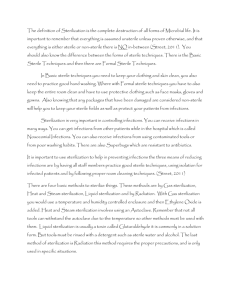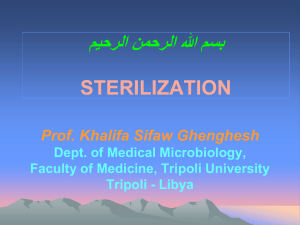INFECTION CONTROL
advertisement
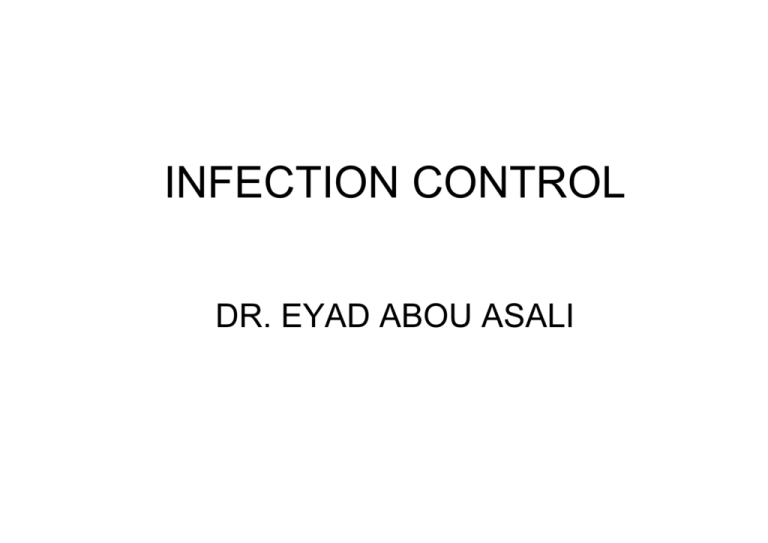
INFECTION CONTROL DR. EYAD ABOU ASALI WHAT IS INFECTION? An invasion of body tissue by microorganism s and their growth there. What is Infection Control: • All of the practices used to prevent the spread of microorganisms that could cause disease in a person. • Infection control practices help to protect clients and healthcare providers from disease by reducing and/or eliminating sources of infection. Types of microorganisms causing infections 1. Bacteria can live and be transported through air, water, food, soil, body tissues and fluids, and inanimate objects. 2. Viruses (causes the common cold) hepatitis, herpes, and human immunodeficiency virus. 3. Fungi include yeasts and molds. Candida albicans 4. Parasites They include protozoa such as the that causes malaria. Microorganisms. vary in their • Ability to produce disease. • Severity of the diseases they produce. • Degree of communicability. Type of infections • Local: limited to specific part of the body. • Systemic: microorganisms spread and damage different of the body. • Bacteremia: when a culture of the person’s blood reveals to microorganisms. • Septicemia: when Bacteremia results in systematic infections. • Acute infections: generally appear suddenly or last a short time. • A chronic infections : occur slowly, over a very long period and may last months or years. What do u know about Nosocomial Infections? • Infections that are associated with the delivery of health care services in a healthcare setting, clients are at increased risk of having infection. • Most nosocomial infections are transmitted by health care workers and clients as a result of direct contact. Nosocomial infections • classified as infections that are associated with the delivery of health care services in a health care facility. Nosocomial infections can either develop during a client's stay in a facility or manifest after discharge. • The incidence of nosocomial infections is significant. Major sites for these infections are the respiratory and urinary tracts, the bloodstream, and wounds. Factors that contribute to nosocomial infection risks are invasive procedures, medical therapies, the existence of a large number of susceptible persons, inappropriate use of antibiotics, and insufficient hand washing after client contact and after contact with body substances. Factors Increasing Susceptibility to Infection 1. Age influence the risk of infection. 2. Heredity influences the development of infection. 3. The nature, number, and duration of physical and emotional stressors can influence susceptibility to infection. • Stressors elevate blood cortisone. Prolonged elevation of blood cortisone decrease antiinflammatory responses depletes energy stores, lead to a state of exhaustion, and decrease resistance to infection. 4. Resistance to infection depends on adequate nutritional status. 5. Some medical therapies predispose a person to infection. For example, radiation treatments for cancer, some diagnostic procedures may also predispose the client to an infection. 6. Certain medication also increase susceptibility to infection. Anticancer medications may depress bone marrow function, resulting inadequate production of white blood cells, antiinflammatory and antibiotics medications. What are the Types of nosocomial infection?(N I) Endogenous NI: Autoinfection (infections occur from the patients’ own. Exogenous NI: occurs from an infected or patient to other patients, health care workers and visitors ( hospital environment and personel). Nosocomial infections lead to • • • • • Increased healthcare costs, Extended hospital stays. Prolonged recovery time. Cause disability and discomfort. Loss of life. Principles of Basic Infection Control: 1. Microorganisms move through space on air currents – avoid shaking or tossing linen. 2. Microorganisms are transferred from one surface to another whenever objects touch. A clean item touching a less clean item becomes “dirty” – keep hands away from face, keep linens away from uniforms, an item dropped on the floor is considered dirty. (cont.) 3. Microorganisms are transferred by gravity when one item is held above another, avoid passing dirty items over clean items 4. Microorganisms are released into the air on droplet nuclei whenever a person breathes or speaks – avoid breathing directly in someone’s face; when someone coughs/sneezes, cover mouth with kleenex, discard, wash hands. 5. Microorganisms move slowly on dry surfaces, but very quickly through moisture. 6. Proper Hand washing removes many of the microorganisms that would be transferred by the hands from one item to another – always wash hands between patients. The Chain of Infection • Infectious agent – microorganisms (bacteria, viruses) able to cause diseases if invade tissue, grow &multiply. • Resident – normally reside on the skin in stable numbers. • Transient – attach loosely to the skin by contact with another – easily removed by hand washing. Host must be susceptible to the strength and numbers of the microorganisms. To reduce susceptibility – • prevent nosocomial infection, • provide adequate nutrition & rest, • promote body defenses against infection & provide immunization. How can we break the Chain of Infection • There are many ways to break the chain of infection in each of the links: look at the next slide) Body Defense Against Disease • Nonspecific Defense System: 1. Anatomic and physiological barriers • Intact skin and mucous membrane. • Normal secretion (acidic) on the skin inhibits bacterial growth. • Nasal passages (moist mucous membranes, and cilia). • The lung have alveolar macrophages. • The eye is protected by tear (inhibiting). • Stomach acidity inhibit growth 2- Specific defenses system It involve the immune system. Antigens : is a substance that induce a state of sensitivity or immune responsiveness (immunity). Antibodies destroy or control antigen providing protection against most common infections. IMMUNITY Active immunity: antibodies are produced by the body in response to an antigen (vaccines). Passive immunity: the host receives natural or artificial (from an injection of immune serum) antibodies are produced by another source (animal, human). Types of Immunity How to prevent of nosocomial infection? • • • • Hand hygiene Break the chain of infection provide adequate nutrition & rest. promote body defenses against infection & provide immunization. • Follow the principles of aseptic technique. • HANDWASHING! is the most important measure you can use to prevent the spread of infection. Cleaning? inhibits the growth of microorganism Disinfecting: Is a chemical preparation, such as phenol or iodine compounds, used on inanimate Sterilization : It is the process of killing or destroys all microorganisms including spores and viruses . A sterile field : It is a microorganism-free area. ASEPSIS • Sepsis: Is the state of infection. • Asepsis : Is the freedom from disease microorganisms. • Clean : absence of almost all microorganisms. • The term asepsis means the absence of disease-producing microorganisms • Aseptic technique is an effort to keep the client as free from exposure to infectioncausing pathogens as possible There are two basic types of asepsis Medical & Surgical asepsis. ASEPSIS • MEDICAL • USED DURING DAILY ROUTINE CARE TO BREAK THE INFECTION CHAIN • SURGICAL • REQUIRES ABSENCE OF ALL MICROORGANISMS 1. Medical asepsis Includes all practices intended to confine a specific microorganism to a specific area, limiting the number, growth, and transmission of microorganisms. In medical asepsis, objects are referred to as clean, which means the absence of almost all microorganisms, or dirty (soiled, contaminated, which means likely to have microorganisms, some of which may be capable of causing infection. 2. Surgical asepsis or sterile Technique, refers to keep an area or object free of all microorganism, it includes practices that destroy all microorganisms and spores. Surgical asepsis is used for all procedures involving the sterile areas of the body. • Sepsis is the state of infection and can take many forms, including septic shock. ASEPSIS IS THE CONTROL OR ELIMINATION OF: • INFECTIOUS AGENTS • CLEANSING • DISINFECTION AND STERILISATION CLEANSING THE REMOVAL OF ALL FOREIGN MATERIALS: • FROM OBJECTS • GENERALLY INVOLVES WATER • MECHANICAL ACTION • WITH OR WITHOUT DETERGENTS DISINFECTION/STERILISATION • DISINFECTION ELIMINATES PATHOGENIC ORGANISMS WITH THE EXCEPTION OF BACTERIAL SPORES • STERILISATION ELIMINATES AND DESTROYS ALL MICROORGANISMS, SPORES AND VIRUSES ASEPTIC TECHNIQUE • A METHOD USED TO PREVENT CONTAMINATION OF WOUNDS AND OTHER SUSCEPTIBLE SITES • USING ONLY STERILE OBJECTS AND FLUIDS Asepsis: Sterilization and Disinfection Asepsis It is keeping medical instruments free from microorganisms This is accomplished by: I. Sterilization II. Disinfection I. Sterilization It is one of the basic steps in surface asepsis. Definition: Sterilization refers to the use of different procedures to destroy all forms of microorganisms including bacterial spores. What to sterilize? • It is mandatory to sterilize : – all instruments that penetrate soft tissues and bone. – Instruments that are not intended to penetrate the tissues, but that may come into contact with oral tissues. • If the sterilization procedure may damage the instruments, then, sterilization can be replaced by Disinfection procedure II. Disinfection It a is less lethal process than sterilization. Definition: It is a procedure intended to reduce microorganisms as far as possible (but not bacterial spores). Thus, disinfection can never replace sterilization Which procedure to use? Category Items in each category Procedure Critical Items that: (1) enter the tissue; (2) Enter vascular system; (3) through which blood flows Sterilization Semi-critical Items that: (1) touch mucous membranes; (2) touch non-intact skin (e.g. endoscopes, respiratory therapy equipment, and diaphragms) High level disinfection Non-critical Items such as bedpans, blood pressure cuffs, and bedside tables Low level disinfection I. Sterilization - Process Sterilization: is a process that destroys all microorganisms, including spores and viruses. • Four commonly used methods of sterilization are 1. Moist heat 2. Gas 3. Boiling water 4. Radiation Sterile Technique The basic principles of surgical asepsis 1. All objects used in a sterile field must be strile. 2. Sterile objects become un-sterile when touched by un-sterile objects. 3. Sterile items that are out of vision or below the waist level of the nurse are considered unsterile. 4.Sterile objects can become unsterile by prolonged exposure to airborne microorganisms. 5. Fluids flow in the direction of gravity. 6. Moisture that passes through a sterile object draws microorganisms from un-sterile surfaces above or below to the sterile surface by capillary action. 7. The edges of a sterile field are considered unsterile. 8. The skin cannot be sterilized and is un-sterile. Sterilization – instrument Packing • Often instruments are packed for sterilization to be stored and handled without being contaminated. • Packing depend on the intended shelf life after sterilization. • The available packing options are: – Textile has shelf life of 1 month – Paper has shelf life of 1 – 6 months – Nylon, glass, and metal have shelf life of 1 year if tightly closed Sterilization Principles There are 3 different sterilization principles: 1. Heat sterilization 2. Chemical sterilization 3. Radiation sterilization Instrument Processing Area • • Use a designated processing area to control quality and ensure safety Divide processing area into work areas – Receiving, cleaning, and decontamination – Preparation and packaging – Sterilization – Storage Automated Cleaning • • • Ultrasonic cleaner Instrument washer Washer-disinfector Manual Cleaning • • Soak until ready to clean Wear heavy-duty utility gloves, mask, eyewear, and protective clothing Preparation and Packaging • • • • Critical and semi-critical items that will be stored should be wrapped or placed in containers before heat sterilization Hinged instruments opened and unlocked Place a chemical indicator inside the pack Wear heavy-duty, puncture-resistant utility gloves Instrument processing flowchart Remove Items from operatory Use holding Solutions if necessary Clean by Automated Or manual method Store Package Sterilize 1. HEAT STERILIZATION 1. Heat Sterilization Advantages: It is the simplest, most effective and inexpensive method. There are 2 procedures depending on the tolerance of the material used: a) Steam sterilization (Autoclaving) b) Dry heat sterilization 1.a. Heat – Steam Sterilization • Use saturated steam above 100º C on packed items. • Objects occupy 4/5 of autoclave volume to facilitate circulation. • Process is divided into 3 periods as follows: – Pre-vacuum period: air is withdrawn from device – Sterilizing period: steam is introduced under pressure to specific temperatures & times. – Post-vacuum: steam is withdrawn to dry autoclave Table shows samples of time-temperature relationships for steam sterilization Steam Sterilization Advantages & Disadvantages • Advantages: – good penetration – maintains integrity of liquids (e.g. Lubricants) due to the 100% humidity within the chamber. • Disadvantages: – Non stainless steel metal items corrode – may damage plastic and rubber items – sharp instruments get dulled. Operation cycle of Steam Sterilization • 4 cycles – 1. heat – up ~~~~~~~ generates steam – 2. sterilization cycle~~~ reaches the temp. needed to sterilize – 3. depression cycle~~releasing the pressure – 4. Drying cycle ~~~~~dries instruments Sterilization Monitoring Types of Indicators • • Mechanical – Measure time, temperature, pressure Chemical – Change in color when physical parameter is reached • Biological (spore tests) – Use biological spores to assess the sterilization process directly 1.b. Dry-Heat Sterilization • Involves heating at atmospheric pressure and often use a fan to obtain uniform temperature by circulation. • Heat at 180º for half hour , 170º for 1 hr., or 160º C for 2 hrs. • Times are the periods during which object is maintained at the respective temp. • Adequate sterilization with heat depends on: – Temperature – Length of time • Higher temperatures require shorter treatment times. • Thermal death time (TDT) is the shortest length of time needed to kill all organisms at a specific temperature. • Thermal death point (TDP) is the lowest temperature needed to kill all organisms in 10 minutes. Dry-Heat Sterilization Disadvantages • Disadvantages: – Less reliable than autoclaving – Large temp difference may arise within device. – sharp instruments get dulled – Many materials do nottolerate dry heat 2. CHEMICAL STERILIZATION 2. Chemical Sterilization - Types • The chemical compounds used can be: a) Gas Sterilization b) Liquid Sterilization • Generally, chemical sterilization procedures have the disadvantages of presenting health hazards to users (e.g. poisonous, flammable, ) 2.a) Gas Sterilization • The gas used in this procedure is ethylene oxide. • Procedure: – Keep objects in constant atmospheric humidity. – Heat to temperatures between 30º and 60º C. – maintain for a period of 10 hrs. – Residual ethylene oxide must be ventilated • Formalin gas autoclaves have been developed for sterilizing endoscopes and ansthetic apparatus. Gas Sterilization – Disadvantages • Ethylene oxide (& formalin) autoclaves have the following disadvantages: – Difficult to operate – Unsuitable for hospitals but used in industry (e.g. for sterilizing disposable materials that can not tolerate high temperatures). 2.b) Liquid Sterilization • Can be performed with buffered glutaric aldehyde. • Procedure: – Immerse object in liquid for several hours. – Rinse with sterile water after end of procedure. 3. RADIATION STERILIZATION 3. Radiation Sterilization • Provides effective way of sterilization when used in high doses. • Gamma radiation (from 60Co). • Procedure: – Objects on belt conveyer – Expose objects to 25 to 30 kGy for about 24 hrs. Radiation Sterilization Advantages and Disadvantages • Advantages: – Clean process – Dry process – Ensures full exposure of object from all directions • Disadvantages: – Posses threat to humans (radiation) – Lengthy process – Requires very qualified personnel II. DISINFECTION • A disinfectant is a chemical preparation, such as phenol or iodine compounds, used on inanimate objects . • Disinfectants are frequently caustic and toxic to tissues. An antiseptic is a chemical preparation used on skin or tissue . Disinfection - Types • As mentioned before, disinfection can not kill all microorganisms but only reduce its number. • Disinfection can be accomplished with: 1. Heat disinfection 2. Chemical disinfection • Object that can be disinfected are bedpans, patient skin before operation and surgeon hands before putting gloves. 1. Heat Disinfection • It is accomplished by boiling water atmospheric pressure for at least 5 min’s at 2. Chemical disinfection • Number of different agents are used according to tolerance of objects and infectious agents. – Using phenol with cleaning component destroy the membrane of microorganisms. – Using 70% alcohol for skin which denatures proteins of microorganisms. – Use soap containing hexachlorophene for hands. – In case of hepatitis use 5% solution of chloramines or heat disinfection A SATISFACTORY AGENT SHOULD: • Be active against a wide range of organisms and spores. Only few are truly sterilizer • Have a rapid action • Should not be toxic or irritant to the skin • Should be Persistent There is no one disinfectant which can be used to kill all micro-organisms in all situations. Types of Chemical disinfectants • Inorganic: – Iodine – Chlorine • Organic: – Alcohols – Aldehydes – Phenols – Cationic surface-active agents Inorganic disinfectants The halogens: Chlorine and Iodine • Have a rapid action against vegetative organisms and spores= true sterilizers • Their action is annulled by foreign organic material Iodine disinfectants The broadest spectrum of all topical antiinfectives, with action against bacteria, fungi, viruses, spores, protozoa, and yeasts. • Tincture iodine: – 2.5% iodine & 2.5% potassium iodide in 90% ethanol. – Best skin disinfectant – Irritating to raw surfaces: due to its alcoholic component – Allergic dermatitis • Iodophors: Solutions of iodine in non-ionic detergents= Povidone iodine= Betadine – Less irritating and less staining – Less disinfectant than tincture • • • • • Chlorine disinfectants Powerful, Disinfect water Particularly active against viruses Concentrated solutions too corrosive Usually diluted with a compatible detergent Organic Disinfectants • Alcohols: bactericidal: 50-70% ethanol • Aldehydes: – Formalin: irritant, powerful=sterilizer – Glutaraldehyde: less irritant, not volatile, more rapid action. • Phenols: continued activity in organic matter as human excreta. – Phenol: Toxic, expensive – Cresols: Lysol – Chloroxylenol: Dettol – Chlorhexidine: Hibitane- Alkanol – Hexachlorophane • Cationic surface-active agents: – Cetrimide: Cetavlon Alcohol • Isopropyl Alcohol 70% (or Ethyl Alcohol 90%) ADVANTAGES: • Causes protein denaturation, cell lysis, and metabolic interruption. • Degreases the skin. DISADVANTAGES: • Ineffective against bacterial spores and poorly effective against viruses and fungi. Glutaraldehyde (Cidex) Cold Sterilization: • Instruments must be dry before immersion. • Glutaraldehyde is bactericidal, fungicidal, viricidal, and sporicidal • Sterilization: a 10 hour immersion. This prolonged chemical action can be more detrimental to surgical instruments. • 3 hours exposure time is needed to destroy spores. • If the instruments need to be "disinfected" only, cold sterilization is okay as disinfection will take place in only 10 minutes. Lysoformin • Formaldehyde & glutaral • Lysoformin: liquid concentrate with which any dilution required can be made by simply adding water (20ml + 48L) • The timing depends on the concentration used: – flexible endoscopes – deactivation of HBV & HIV • Used for heat labile instruments and cleaning • Does not harm metal instruments Chlorhexidine Gluconate Hibitane vs Alkanol Broadest spectrum Better residual activity than iodophors Occasional skin sensitivity ADVANTAGES: Rapid action Residual activity is enhanced by repeated use Less susceptible to organic inactivation than povidone iodine DISADVANTAGES: Occasional skin sensitivity. Inactive against bacterial spores Activity against viruses and fungi is variable and inconsistent May harm metal instruments Disinfectant Status Use Alcohols (70% or 90%) (intermediate-level) bactericidal, tuberculocidal, fungicidal, and virucidal to disinfect thermometers, medication vials, etc. Glutaraldehyde (high-level) broad antimicrobial range, fungicidal and virucidal to disinfect endoscopes, thermometers, and rubber items Chlorine Compounds (dilution of 1:50 is highlevel) concentrations of 1000 ppm inactivate bacterial spores to disinfect countertops, floors, other surfaces Orthophthalaldehyde (high-level) bactericidal, virucidal, fungicidal, tuberculocidal in 12 minutes at room temperature to clean and process endoscopes Hydrogen Peroxide (lowlevel) 6% solutions effective against some bacteria, fungi, and viruses may be used to clean work surfaces, not widely used in health care settings Iodine and Iodophors (intermediate-level) vegetative bactericidal, M. tuberculosis, most viruses and fungi, no sporicidal capability may be used as disinfectant or antiseptic Phenolics (intermediate- or low-level) most formulations are tuberculocidal, bactericidal, virucidal, and fungicidal have toxic effects, used as environmental not sporicidal disinfectants Quaternary Ammonium Compounds not recommended for high-, intermediate- or lowlevel disinfection cleaning agents for noncritical surfaces Asepsis – Summary Asepsis Sterilization Heat Disinfection Chemical Steam Dry heat Radiation Gas Heat Gamma Chemical Boiling water Phenol Ethylene oxide 70% Alcohol Formalin Hexachlorophene Heat or chloramines solution Liquid Glutaric Aldehyde PROPER INSTRUMENT PROCESSING DECONTAMINATION CLEANING HIGH-LEVEL DISINFECTION STERILIZATION STEAM Under pressure DRY HEAT CHEMICAL BOILING USED OR STORED CHEMICAL STEAM • When disinfecting articles, nurses need to follow agency protocol and consider the following: Ultraviolet Light Sterilization Ultraviolet (UV) light has been used to help disinfect the air for more than 50 years. For example, UV irradiation can interrupt transmission of airborne infections in enclosed indoor environments where living conditions are poor and people are crowded together. Because UV irradiation has very limited energy, UV light does not penetrate dust, mucous or water. Therefore, despite manufacturers= claims, it cannot be used to sterilize water. Although in theory intense UV light can be both bactericidal and viricidal, in practice only limited disinfection of instruments can be achieved. This is because the UV rays can kill only those microorganisms that are struck directly by UV light beams. For surfaces that cannot be reached by the UV rays (e.g., inside the barrel of a needle or laparoscope), any microorganisms present will not be killed. Other disadvantages of UV: • It requires a reliable source of electricity. It is not effective in areas of high relative humidity. • UV bulbs require frequent cleaning to remain effective. • Exposure to UV rays can burn the skin and eyes. • As a consequence, UV irradiation is neither a practical nor effective method in most situations Conclusion • In summary: – Sterilization and disinfection are costly and time consuming process – However, it is an essential in all health care facilities to avoid spread of diseases. – It depends on the ehtics of the instrument users. – Users should keep in mind that contaminated instrument present risk to patient as well as the user himself. The Early OR: No Masks Required Masks and gowns3 for some Masks, Gowns3and a Nun Minimally Invasive Brain Surgery Presbyterian Hospital How to Enter the OR • • • • • • Change into clean scrubs Remove all jewelry, watches and rings Remove your pager and cell phone Put on a surgical cap, mask, shoe covers Hair must be completely covered Mask must be tied before entering the OR Caps The Bouffant The Cap Masks and Eye Protection No! • Wrong mask, no eye protection No! • Ditto Masks and Eye Protection + Better! Best! Outside the OR: Key People/Areas • “The Front Desk” • “Charge Nurse” – In charge of all the OR staffing, equipment, troubleshooting • OR Secretary – Calls patients to the OR, coordinates the OR schedule – Just slightly less busy than an air traffic controller • Preoperative Holding Area (“Preop Hold”) • “Recovery” • Recovery Room Nurses Front Desk: Montefiore OR The OR Team • “Circulator” (AKA The Boss) – A nurse responsible for patient care and safety, medical record documentation, OR equipment – Helps obtain and keep track of instruments and supplies (circulating between sterile and non-sterile fields) • “Scrub” – An OR Tech or RN who gowns and gloves the surgeons; also sets up, maintains and passes instruments within the sterile field • “Anesthesia” – Attending Anesthesiologist, Resident or CRNA, Medical Students, Anesthesia Tech – Administers preoperative sedation, intraoperative anesthesia, and postoperative analgesia in the Circulator: Montefiore OR 36 Opening sterile pack • Passing sterile object to a sterile person • Putting an object in the sterile field Scrub: Montefiore OR 36 Anesthesia: Montefiore OR 36 The Instrument Table The Mayo Stand Once you are scrubbed in, gowned and gloved4.. Where is the sterile field?? Or, What am I allowed to touch?? and@ Where do I put my hands?? Where is the sterile field? • You: – Front of the gown from chest to the waist – Gloved hands and arms to the elbows • Patient: – Draped part down to the OR table – Anything that falls below the level of the patient table is considered contaminated • Sterile Field: – Covered part of the “Mayo stand” (small table where the most commonly used instruments are kept) – Top of the “Back Table” where additional instruments are kept. The sides of the Back Table are not considered sterile – Disposable light handles The Sterile Field ANY QUESTIONS??????
